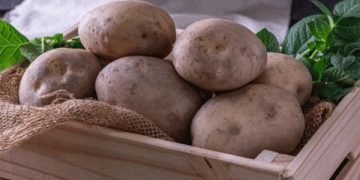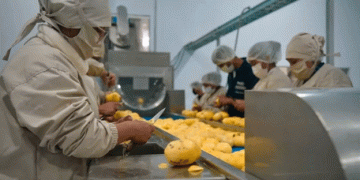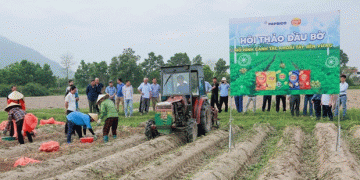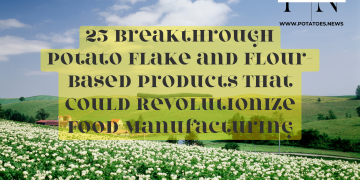#PotatoProtein #SustainableAgriculture #PlantBasedProtein #AgriculturalInnovation #EcoFriendlyFarming #NutritionalRichness #GlobalProteinDemand #AminoAcids #EnvironmentalSustainability
In the Internet age, there is a famous saying: “The wool comes from the pig, but the dog pays the bill.” Indeed, it is an innovative business model and a new concept of thinking for creating profits.
According to the traditional view, the main product of potato starch processing is “starch”. The profitability of a company mainly depends on the cost of raw materials, the price of starch and the control of processing costs. In short, you can make money if starch is sold at a high price, but you cannot make money if it is sold at a low price.
However, over the past two years, the profit models of many potato companies with astute thinking and processing innovation have quietly changed. These by-products are potato residues.
The manager of a potato starch processing plant in the northwest tallied the books for this author: the plant produces more than 200 tons of starch every day, extracts more than 15 tons of protein and produces more than 1,000 tons of dehydrated potato residues. A ton of protein costs 6,500 yuan, the daily income of protein is about 100,000 yuan, the dehydrated potato residue is 80 yuan per ton, and the daily income of potato residue is more than 80,000 yuan. The production season is 50 days, and the net profit from by-products is 9 million yuan. Even if the starch doesn’t bring in a penny and is sold entirely at cost, the company can still make a profit.
Protein extraction has become standard
Initially, the extraction of potato protein in my country was not driven by its value, but by environmental protection requirements. After actual extraction, potato protein was found to be an excellent plant protein.
In 2019, the China Starch Manufacturers Association and the China Light Industry Cleaner Production Center jointly drafted the “Technical Specifications for Potato Protein Powder Extraction Operations” and the “Product Standard for Potato Protein Powder” with the participation of 10 major key companies in the industry. The standards were released on August 18 of the same year, officially released, and played an important guiding role in the entire industry, mainly realizing the environmentally friendly, environmentally friendly, healthy and sustainable development of the potato starch processing industry.
Now 90% of domestic potato starch processing enterprises carry out protein extraction, which not only solves the problem of juice processing, but also collects high-quality protein. Potato protein has high nutritional value and is rich in lysine, methionine, threonine and tryptophan. Although the protein content of potato tubers, which is the world’s staple food, is not very high, extracting protein from the huge amount of water used to process starch is still important.
Nutrition experts note that the quality of potato protein is very similar to animal protein. Although potato protein is a non-traditional source of protein, it is becoming increasingly important as global demand for protein increases.
Potato protein contains a large amount of mucilage protein, which is a mixture of polysaccharide proteins that can prevent the deposition of fat in the cardiovascular system, maintain the elasticity of the arteries, prevent premature atherosclerosis, and also prevent atrophy of the connective tissues of the liver and kidneys. maintaining lubrication of the respiratory and digestive tracts. Potato protein, like sweet potato protein, may prevent and treat collagen diseases. In addition, potato protein is also a very useful health food for middle-aged and elderly people and has important physiological effects on health.
Potato protein is a powdered product obtained from the juice of potato starch processing through pH adjustment, heating, flocculation, dehydration, drying and other processes. It is what people in the industry commonly call a by-product of potato starch production. Now the plant, which processes 10,000 tons of starch per year, can produce more than 1,000 tons of protein powder annually.
According to reports, the price of potato protein powder on the European market is around 1100-1300 euros/ton (with a content of more than 60%). Of course, the higher the content, the higher the cost. In the past few years, the price of domestic potato protein has not been fully recognized by the market due to the overall production volume. about 6500 yuan per ton. .
We believe that potato protein, as a protein with high nutritional value and rich in many essential amino acids for the human body, has significantly better energy and protein nutritional value than soybean meal and corn protein. Therefore, potato protein will have very broad development prospects in the future.
Potato residues show diversified utilization trend
Five years ago or a few years ago, potato scraps such as juice were the most troublesome “waste” for potato starch processing companies. During the production season, potato residues accumulate everywhere, and with the onset of spring, potato residues ferment and acquire an unpleasant odor, seriously polluting the air.
Thanks to strict environmental controls and improved production technology, potato residues are no longer “waste” and are turned into meat and potatoes into animal feed.
The author noticed that in recent years two types of potato waste have gained the most popularity. One is semi-dry potato residue (containing about 70% moisture) after simple dehydration, which can be sold at about 80 yuan per ton and mainly used as animal feed. Potato residues contain protein, fine starch, vitamins, trace elements, etc., which are organic nutrients required for the production of animal feed. Mixing potato residues with straw to produce fermented feed is the most ideal feed for animal health and has many benefits. Good market prospects.
The second is to dry the remaining potatoes. Some companies in Inner Mongolia and northwest China use tube drying or flash drying processes to dry potato residues. Dried potato residues are high-quality raw materials for fish bait and pet food, with a market value of more than 1,500 yuan per ton.
Whether dehydration or drying out, this is not the end of potato scrap disposal. Because potato leftovers are rich in dietary fiber, accounting for about 20% of dry weight, they are a safe and high-quality source of dietary fiber. Dietary fiber products made from potato residues are white in color, have high water-holding capacity and swelling ability, and have good physiological activity. Potato dietary fiber has a very good effect on human health, such as constipation, colon cancer, cholelithiasis, atherosclerosis, obesity, etc. In addition, potato dietary fiber can also provide very high nutritional value. It can not only increase the content dietary fiber in foods, reduce the number of calories in food, stimulate human metabolism, but also help prevent diseases of the intestinal system and cardiovascular diseases. Systemic diseases.
Therefore, potato dietary fiber is known abroad as the “seventh essential food element” and is widely used in the food industry, such as meat products, bakery products and puff pastries. Now high-quality potato dietary fiber in the EU can be sold for 3,000 euros per ton.
Finally, the starch content of potato tubers is 13.2–20.5%, with both linear and branched structures, the protein content is 1.6–2.1%, the quality is close to animal protein, comparable to eggs, rich 18 types of Amino Acids, which are easily digested and absorbed by the human body, also contain essential nutrients such as dietary fiber, vitamins and minerals. Therefore, it is not an exaggeration to call potatoes a “treasury of nutrition.”
Currently, the domestic development of this “treasury” is based on only one direction: for example, the starch processing industry focuses only on the extraction of starch and ignores the effective development of other nutrients such as protein, fiber and amino acids. Thus, the author believes that a new development trend could be diversified potato processing by “eating it dry and squeezing it all out” and “all-in-all”, or “obtaining value from by-products of potato starch processing”






